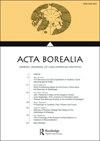The Sami cooperative herding group: the siida system from past to present
IF 0.6
4区 社会学
0 HUMANITIES, MULTIDISCIPLINARY
引用次数: 3
Abstract
ABSTRACT The Sami siida has been described as an organizational institution tailored to meet the dynamic demands of reindeer herding. Historically, it has been characterized as a relatively small group based on kinship. It was formed around a core sibling group and distinguished by a norm of equality where herding partners were equals regardless of social status. Moreover, it was informally led by a wealthy and skilfull person whose authority was primarily related to herding. One of the critical aspects of the siida was flexibility: composition and size changed according to the season, and members were free to join and leave the groups as they saw fit. This comparative study of the current status of the siida system in the Northern and Southern parts of Norway shows that the main difference between the historical representation of the siida system and today concerns a loss of flexibility. Only two herders reported to have changed summer and winter siida since 2000. Furthermore, while the siida continues to be family-based, leadership is becoming more formal. Nevertheless, decision-making continues to be influenced by concerns of equality.萨米合作牧群:从过去到现在的siida制度
萨米siida被描述为一个为满足驯鹿放牧的动态需求而量身定制的组织机构。从历史上看,它的特点是一个基于亲属关系的相对较小的群体。它是围绕一个核心兄弟姐妹群体形成的,并以平等的规范为特征,即无论社会地位如何,放牧伙伴都是平等的。此外,它由一个富有而有技巧的人非正式地领导,他的权威主要与放牧有关。siida的一个关键方面是灵活性:组成和大小根据季节变化,成员可以自由加入和离开他们认为合适的团体。这项对挪威北部和南部siida系统现状的比较研究表明,siida系统的历史表现与今天的主要区别在于灵活性的丧失。据报道,自2000年以来,只有两名牧民改变了夏季和冬季的锡达。此外,虽然siida仍然以家庭为基础,但领导层正变得更加正式。然而,对平等的关切继续影响着决策。
本文章由计算机程序翻译,如有差异,请以英文原文为准。
求助全文
约1分钟内获得全文
求助全文

 求助内容:
求助内容: 应助结果提醒方式:
应助结果提醒方式:


